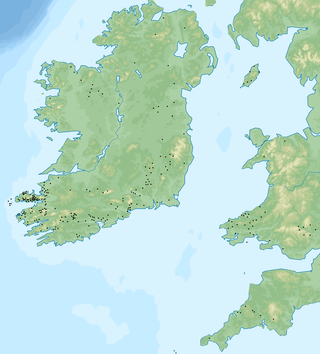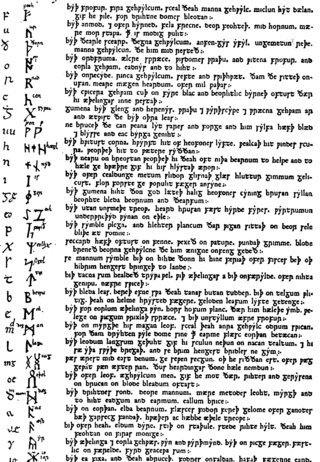
The Celtic languages are a group of related languages descended from Proto-Celtic. They form a branch of the Indo-European language family. The term "Celtic" was first used to describe this language group by Edward Lhuyd in 1707, following Paul-Yves Pezron, who made the explicit link between the Celts described by classical writers and the Welsh and Breton languages.
Old English, or Anglo-Saxon, is the earliest recorded form of the English language, spoken in England and southern and eastern Scotland in the early Middle Ages. It developed from the languages brought to Great Britain by Anglo-Saxon settlers in the mid-5th century, and the first Old English literary works date from the mid-7th century. After the Norman conquest of 1066, English was replaced, for a time, by Anglo-Norman as the language of the upper classes. This is regarded as marking the end of the Old English era, since during this period the English language was heavily influenced by Anglo-Norman, developing into a phase known now as Middle English in England and Early Scots in Scotland.

Wicca is a modern neo-pagan syncretic religion. Scholars of religion categorize it as both a new religious movement and as part of occultist Western esotericism. It was developed in England during the first half of the 20th century and was introduced to the public in 1954 by Gerald Gardner, a retired British civil servant. Wicca draws upon a diverse set of ancient pagan and 20th-century hermetic motifs for its theological structure and ritual practices.

Geomancy is a method of divination that interprets markings on the ground or the patterns formed by tossed handfuls of soil, rocks, or sand. The most prevalent form of divinatory geomancy involves interpreting a series of 16 figures formed by a randomized process that involves recursion, followed by analyzing them, often augmented with astrological interpretations. Geomancy was also thought by figures such as Richard II to be a greater discipline that included philosophy, science, and alchemic elements.
Solomon and Saturn is the generic name given to four Old English works, which present a dialogue of riddles between Solomon, the king of Israel, and Saturn, identified in two of the poems as a prince of the Chaldeans.

Lepontic is an ancient Alpine Celtic language that was spoken in parts of Rhaetia and Cisalpine Gaul between 550 and 100 BC. Lepontic is attested in inscriptions found in an area centered on Lugano, Switzerland, and including the Lake Como and Lake Maggiore areas of Italy. Since it is "P-Celtic," the name could from a Proto-Celtic *leikwontio-.

Ogham is an Early Medieval alphabet used primarily to write the early Irish language, and later the Old Irish language. There are roughly 400 surviving orthodox inscriptions on stone monuments throughout Ireland and western Britain, the bulk of which are in southern Munster. The largest number outside Ireland are in Pembrokeshire, Wales.
Insular Celtic languages are the group of Celtic languages spoken in Brittany, Great Britain, Ireland, and the Isle of Man. All surviving Celtic languages are in the Insular group, including Breton, which is spoken on continental Europe in Brittany, France. The Continental Celtic languages, although once quite widely spoken in mainland Europe and in Anatolia, are extinct.
Wolfsangel or Crampon is a heraldic charge from Germany and eastern France, which was inspired by medieval European wolf traps that consisted of a Z-shaped metal hook that was hung by a chain from a crescent-shaped metal bar. The stylized symbol of the Z-shape can include a central horizontal bar to give a Ƶ-symbol, which can be reversed and/or rotated; it is sometimes mistaken as being an ancient rune due to its similarity to the "gibor rune" of the pseudo Armanen runes.

Mabel Emily Besant-Scott ("Mabs") was a Theosophist, Co-Freemason and Rosicrucian.

The New Forest coven were an alleged group of witches who met around the area of the New Forest in southern England during the early 20th century. According to his own claims, in September 1939, a British occultist named Gerald Gardner was initiated into the coven and subsequently used its beliefs and practices as a basis from which he formed the tradition of Gardnerian Wicca. Gardner described some of his experiences with the coven in his published books Witchcraft Today (1954) and The Meaning of Witchcraft (1959) although on the whole revealed little about it, saying he was respecting the privacy of its members. Meanwhile, another occultist, Louis Wilkinson, corroborated Gardner's claims by revealing in an interview with the writer Francis X. King that he too had encountered the coven and expanded on some of the information that Gardner had provided about them. According to Gardner, the faith which they followed was the continuation of the Witch-Cult, a pre-Christian religion that originated in the paganism of ancient Western Europe. This was in keeping with the widely held theories then propagated by the anthropologist Margaret Murray and her supporters.

A craft name, also referred to as a magical name, is a secondary religious name often adopted by practitioners of Wicca and other forms of Neopagan witchcraft or magic. Craft names may be adopted as a means of protecting one's privacy, as an expression of religious devotion, or as a part of an initiation ritual. It may also be used as a protective method, as it is believed by some that one's "true name" can be used to identify that person for the purpose of magical activities.

Roughly 400 known ogham inscriptions are on stone monuments scattered around the Irish Sea, the bulk of them dating to the fifth and sixth centuries. Their language is predominantly Primitive Irish, but a few examples record fragments of the Pictish language. Ogham itself is an Early Medieval form of alphabet or cipher, sometimes known as the "Celtic Tree Alphabet".
Protistology is a scientific discipline devoted to the study of protists, a highly diverse group of eukaryotic organisms. All eukaryotes apart from animals, plants and fungi are considered protists. Its field of study therefore overlaps with the more traditional disciplines of phycology, mycology, and protozoology, just as protists embrace mostly unicellular organisms described as algae, some organisms regarded previously as primitive fungi, and protozoa.

Odin is a widely revered god in Germanic paganism. Norse mythology, the source of most surviving information about him, associates him with wisdom, healing, death, royalty, the gallows, knowledge, war, battle, victory, sorcery, poetry, frenzy, and the runic alphabet, and depicts him as the husband of the goddess Frigg. In wider Germanic mythology and paganism, the god was also known in Old English as Wōden, in Old Saxon as Uuôden, in Old Dutch as Wuodan, in Old Frisian as Wêda, and in Old High German as Wuotan, all ultimately stemming from the Proto-Germanic theonym *Wōðanaz, meaning 'lord of frenzy', or 'leader of the possessed'.
In Modern English, the term Wicca refers to Wicca, the religion of contemporary Pagan Witchcraft. It is used within the Pagan community under competing definitions. One refers to the entirety of the Pagan Witchcraft movement, while the other refers explicitly to traditions included in what is now called British Traditional Wicca.

Madeline Montalban was an English astrologer and ceremonial magician. She co-founded the esoteric organisation known as the Order of the Morning Star (OMS), through which she propagated her own form of Luciferianism.

The Old English rune poem, dated to the 8th or 9th century, has stanzas on 29 Anglo-Saxon runes. It stands alongside younger rune poems from Scandinavia, which record the names of the 16 Younger Futhark runes.
Mary Winifred Parke, FRS, was a British marine botanist and Fellow of the Royal Society (1972) specialising in phycology, the study of algae.

A Romano-Celtic temple is a sub-class of Roman temple found in the north-western provinces of the Roman Empire. Many may have had roots in the late Iron Age either in direct relation to pre-Roman structures or on sites with pre-Roman activity.












